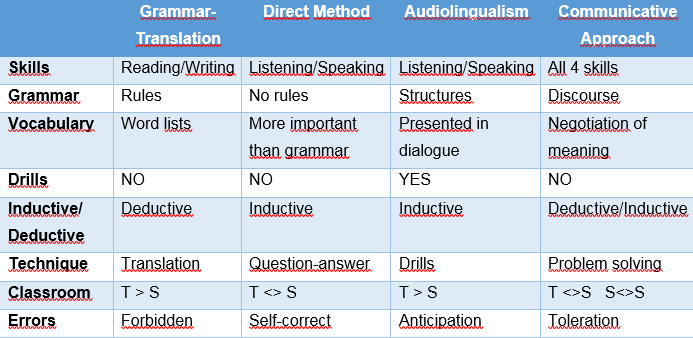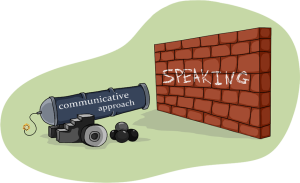What is the communicative approach
What is the communicative approach
The Communicative Approach
What is it?
Communicative language teaching (CLT) is an approach to language teaching that emphasizes interaction and communicative competence as the main goal of study. It consists of learners working in pairs or groups using language resources in problem-solving tasks.
Communicative approaches generally consist of two parties involved in an interaction where one party has an intention and the other reacts or expands on it. Since the communicative method is a broad approach rather than a specific teaching methodology, it appeals to many practitioners who interpret it in different ways. Howatt (1984) distinguishes between a “strong” and a “weak” version of CLT.
The “strong” version claims that language is acquired through communication, while the “weak” version (which has become standard practice nowadays) stresses the importance of using the language for communicative purposes within a wider program of language teaching. In other words, while the “weak” version means “learning to use the language”, the “strong” version entails “using the language to learn it.”
The learning theory behind this approach is that “activities that involve real communication promote learning.” Consequently, learning activities are selected according to how well they engage the learner in meaningful language use.
This led to the creation of communicative syllabi, consisting of a combination of structural and functional items like a) situations where learners typically need to use the L2 (e.g travel, business) b) topics they need to talk about (e.g education, shopping) c) the functions they need the language for (e.g describing something, requesting information) d) vocabulary and grammar.
A communicative syllabus © New English File
What are its activities?
The range of communicative activities is very large, provided they engage the learners in communication and require the use of the language for information sharing, negotiation of meaning or interaction. Some examples are: information gap, dialogues and role-plays, interviews, debates, or language exchanges. Richards and Rodgers (2001) classify communicative materials into three types:
Text and task-based materials © New English File
Criticism
Communicative approaches (in their strong version) have a great appeal because of the implication that learning by talking means “not learning grammar.” However, since language is composed of grammar, trying to learn a L2 without grammar is like trying to learn math without numbers.
Whenever you learn a language you are learning grammar either deductively or inductively. But learning grammar “inductively” (e.g through the context) does not mean not learning at all. In fact, the more inductive the learning, the more you have to turn to your analytical skills. In other words, the less you understand, the more you have to figure out what it means.
This is why communication alone is not “the key” to learning a L2. As Swan (1985) points out, “grammar has not become any easier since the communicative revolution.” There is a difference between learning and practicing with the language. Throwing balls over a net does not mean that you’re learning how to play tennis. This is why it is important to combine communication with form-focused instruction and activities to provide scaffolded learning.
Summary
Although in practice they tend to overlap, here’s a summary of the most noticeable differences between the four most common language learning approaches:
Howatt, A. P. R. (1984). A History of English Language Teaching. Oxford: Oxford University Press.
Richards, J., & Rodgers, T. (2001). Approaches and Methods in Language Teaching. New York: Cambridge University Press.
Swan, M. (1985). A critical look at the Communicative Approach (2). English Language Teaching Journal, 39(2), 76–87.
🙋Communicative approach in its practical meaning
📝Communicative approach – general facts
The main idea of the communicative approach lies in the fact that we focus not on studying a language as a matter but on using this language in real-life situations. The learning process is not about accumulation of grammar and vocabulary but about communication using the skills which are already available.
Here are the main principles of the communicative approach in teaching:
Let’s review these principles from the point of view of their use in the classroom.
☑️Main principles and their practical application
Studying a language is learning to communicate using the target language.
What does a typical lesson look like? Writing out a list on new words, translating some texts using them, opening the brackets for some grammatical rule. But that never gives your student an ability to use the vocabulary he learnt in real life. So the aim of the communicative class is to teach your student to use those words by practicing real-life communication.
In a class with a young learner that looks as following:
❌NOT writing down new words: “go straight ahead – [translation], turn left – [translation]”…
✔️ BUT looking at a map together and describing the way from point A to point B.
All the activities you use at the lesson should have a communicative purpose.
When choosing an activity for the lesson a teacher needs to keep just 1 question in mind: “What will my student learn to do after completing this?”
In practical meaning, the aim of an activity is:
❌NOT “to learn descriptive adjectives”
✔️ BUT “to learn describing a friend’s appearance”.
In a class with a young learner top communicative tasks are:
Actually every level of All Right syllabus has communicative aims formulated in the beginning.
For example, here are some communicative aims of Charlie Starter 1 course:
Four language skills – speaking, listening, reading and writing — should be developed simultaneously.
This is a tricky moment. Sure enough, communication can be both oral and written, so a teacher implements tasks for all 4 skills, but… sometimes this results in a bunch of reading-writing exercises, maybe one or two listening-reading-writing tasks, which is definitely NOT about communicative approach. It might be easier to focus on the idea that speaking is a priority, so that reading, listening and writing will be added to the lesson naturally without any special focus.
Online teaching is actually the best way to practice communicative approach. There are not many ways to organize the student’s writing at the lesson, so speaking becomes number one activity.
In an online class with a young learner the time should be divided between the activities in the following way:
60% – speaking (at least half of that is student’s speaking part)
20% – listening (a song or a short video for 2-3 min will be enough)
10% – reading (mostly as a part of some other task)
10% – writing (if any at all)
All the rest of listening/reading/writing activities can be sent as a homework.
The topics of the course are selected according to student’s age, level, interest and learning aims.
That’s the easiest part: we talk about pets, friends and school with small kids and about technology, movies and modern music with teenagers. BUT a good communicative class should also include the topics interesting for this particular student.
Let’s imagine the following situation:
Student: girl, 7 y.o.
Level: beginner (A0)
Interests: “My little pony”, drawing
Learning aims: speaking practice, no reading/writing
Topic of the current lesson: pets
What could a teacher implement at the lesson besides the coursebook?
Motivation is top important.
What is the highest motivation for a young learner?
Trial and error is considered part of the learning process.
What is the main reason of the famous “language barrier”? (spoiler: NOT lack of knowledge).
That’s fear of making a mistake.
It is a pity but the students often face dispraise from parents and school teachers for not showing immediate 100% success at language learning.
So the aim of the teacher in a communicative class is to help the student start speaking no matter how many mistakes he makes in the beginning. Every attempt is great. Every error leads to improvement.
In an class it is much better to say “Try again” instead of “You are wrong” (by the way, the animated character in All Right classroom is able to do that!).
Запишитесь на
бесплатный урок!
Бесплатный онлайн-урок вместе с Allright:
Скидка 10% за подписку!
Подписывайся на рассылку: мы отправляем полезные чеклисты,
советы по воспитанию и обучению ребенка, а также секретные промокоды, например 10% за эту подписку 😉
*промокод действует только при первой оплате
Communicative Approach
Namespaces
Page actions
It switched traditional language teaching’s emphasis on grammar, and the teacher-centred classroom, to that of the active use of authentic language in learning and acquisition. [1]
Contents
Outline [ edit | edit source ]
CLT is interested in giving students the skills to be able to communicate under various circumstances. As such, it places less emphasis on the learning of specific grammatical rules and more on obtaining native-speaker-like fluency and pronunciation. Students are assessed on their level of communicative competence rather than on their explicit knowledge.
It is more of an approach or philosophy than a highly structured methodology. David Nunan famously listed five key elements to the communicative approach: [2]
History [ edit | edit source ]
Communicative language teaching has been the centre of language teaching discussions since the late 1960s (Savignon & Berns, 1984, p.4). Over the years it had become clear to its proponents that mastering grammatical forms and structures did not prepare the learners well enough to use the language they are learning effectively when communicating with others. As a result, situational language teaching and its theoretical conjectures were questioned by British linguists. Some of the linguists had the task of providing the Council of Europe with a standardized programme for foreign language teaching. D. A. Wilkins was one of them, and his work has had the greatest impact on current materials for language teaching (Savignon & Berns, 1984, p.10). He analyzed the existing syllabus types (grammatical and situational) and the communicative meanings that a language learner needs to understand.
In place of the existing syllabus Wilkins proposed a notional syllabus. This syllabus was not organized in terms of grammatical structures but rather specified what meanings the learners needed in order to communicate. What began as a development only in Britain has expanded since the mid 1970’s. Now it is seen as an approach that pursues two main goals.
The first one is “to make communicative competence the goal of language teaching” and the second one, “to develop procedures for the teaching of the four language skills that acknowledge the interdependence of language and communication” (Richards & Rodgers, 2001, p.155). Another important name associated with communicative language teaching is A. P. R. Howatt. He differentiates between a “strong” and a “weak” version of communicative language teaching.
Howatt states that “a strong version is the development of a language through communication” (1984, p.279) doesn’t mean reactivating existing knowledge of the language but rather prompting the development of the language system itself. However, the “weak” version focuses on providing the learner with sufficient opportunities to speak the language and to put that in the centre of language teaching (Howatt, 1984, p.279).
Theory and characteristics [ edit | edit source ]
As the name implies, the central concept in communicative language teaching is “communicative competence” (Richards & Rodgers, 2001, p.159). This covers both the spoken and written language and all four language skills. As Oxford states, the “development of communicative competence requires realistic interaction among learners using meaningful, contextualized language” (1990, p.8).
Learning strategies, like allowing learners to become more self-directed and more independent in learning the new language help them to participate actively in communication. In her book “Interpreting Communicative Language Teaching: Contexts and Concerns in Teacher Education” Savignon includes a useful summary of the eight characteristics of communicative language teaching by the linguist M. Berns:
One major feature of communicative language teaching is pair and group work. This type of work “is suggested to encourage students to use and practice functions and forms” (Richards & Rodgers, 2001, p.171). That helps the students to become more independent and to accept responsibility.
Learner and teacher roles [ edit | edit source ]
Communicative language teaching emphasizes “self-direction for the learners”. (Oxford, 1990, p.10) As the teacher won’t be around to guide them the whole time, especially not when the learners speak the language outside the classroom they are expected to take on a greater degree of responsibility for their own learning. According to Oxford, “this is essential to the active development of the new language” (1990, p.4). The learner should enter into situations where communication takes place as much as possible to increase his or her communicative proficiency.
Teachers no longer rely on activities that require repetition, accuracy and the memorization of sentences and grammatical patterns; instead, they require the learners to negotiate meaning and to interact meaningfully in the new language. Learners have to participate in classroom activities based on a cooperative rather than individualistic approach to learning; they need to listen to their peers in order to carry out group work successfully.
The teacher adopts different roles. On the one hand she is a “facilitator, a guide and a helper” and on the other hand a “coordinator, an idea-person and a co-communicator” (Oxford, 1990, p.10). She talks less and listens more to the students’ output. In addition to that, the teacher also identifies the students’ learning strategies and helps the students to improve them if necessary and shows them how to work independently. Instructional tasks become less important and fade into the background. That doesn’t mean that they aren’t used at all, but with less significance.
These changes give the teacher more scope for variety and creativity and she gives up her status as a person of authority in a teacher-learner hierarchy. It is the teacher’s responsibility to be creative and prepare appropriate material at home. The teacher can also assume other roles, for example the needs analyst, the counselor or the group process manager (see Richards & Rodgers, 2001).
Materials and how they can be used [ edit | edit source ]
Materials play an important role in communicative language teaching. They provide the basis for communication among the learners. According to Richards & Rodgers, there are three basic types of material (2001, p.168). These are text-based materials, task-based materials and realia.
Text-based material like textbooks will, if designed on CLT principles, offer the learners many kinds of prompts on which they can build up conversations. They will typically contain visual cues, pictures and sentence fragments which the learners can use as a starting point for conversation. Other books consist of different texts the teacher can use for pair work. Both learners get texts with different information and the task is to ask each other questions to get to know the content of the missing piece.
Task-based material consists of exercise handbooks, cue cards, activity cards, pair-communication practice materials and student-interaction practice booklets.
Pair-communication practice material contains material contains two sets of material for a pair of students. It is similar to a task using text-based material. Both students have different kinds of information and through communication they need to put the parts together. Other pair-work tasks involve one student as an interviewer and the other one the interviewee. Topics can range from personal experience and telling the other person about one’s own life and preferences to talking about a topic that was discussed in the news recently or is still up-to-date.
Using realia in communicative language teaching means using authentic material, for example newspaper articles, photos, maps, symbols, and many more. Material which can be touched and held makes speaking and learning more concrete and meaningful. Maps can be used to describe the way from one point to another and photos can be used for describing where things are placed, in front of, on top of or underneath something, and so on.
A classic example of a communicative classroom activity is the “jigsaw-activity”: As Richards points out, “functional communication activities require students to use their language resources to overcome an information gap or solve a problem” (2006, p.18). Usually the class is divided into several groups and each group has a different piece of information needed to complete an activity. The task of the class is to fit all the pieces together to complete the whole. They must use their language resources and communicative strategies to communicate with each other in order to get the information the groups do not have.
An example of a “jigsaw-activity” would be the following: The teacher prepares a topic that’s interesting for the students and fits into the curriculum. For example the students could learn about Britain when introducing the country. The teacher splits the class into four to five groups, depending on the number of students. He/she does this by counting from A- D/E and afterwards all the A’s, B’s, and so on sit together. Every group gets a text containing information on Britain, for example about politics, sights or differences to Germany. The learners take notes and help each other when questions arise. They are then rearranged into groups containing a person from group A, one from B, one from C, and so on. Now the learners discuss and exchange the information they worked on in the first groups so that everyone has all the information about Britain and is able to answer questions the teacher could ask. This activity forces the pupils to talk, even the ones who do not normally speak that much in class, because they are all dependent on the information another student has.
Advantages and disadvantages [ edit | edit source ]
-The most obvious advantage in communicative language teaching is that of the increase of fluency in the target language. This enables the learners to be more confident when interacting with other people and they also enjoy talking more. The approach also leads to gains in the areas of grammatical/sociolinguistic/discourse/strategic competence through communication.
-Another point concerning the teacher might be that it depends on the teacher how motivating or boring the lesson will be. The teacher needs to prepare the material at home and needs to make it as motivating and creative as possible so that the students find the tasks meaningful and motivating, and are eager to communicate with each other.
A critical look [ edit | edit source ]
In 1985, Michael Swan published his «A critical look at the Communicative Approach» in the ELT Journal (Parts 1 [3] and 2 [4] ) to which Henry Widdowson, the leading guru of the communicative approach, replied. [5] [6]
In the first part of his «Critical look», after acknowledging the major contributions the Communicative Approach has made to modern foreign language teaching, Swan points out two, complementary, drawbacks, based on what he perceives is its dogmatic approach: the apparent «belief that students do not possess, or cannot transfer from their mother tongue, normal communication skills» and «the ‘whole-system’ fallacy» which «arises when the linguist, over-excited about his or her analysis of a piece of language or behaviour, sets out to teach everything that has been observed (often including the metalanguage used to describe the phenomena), without stopping to ask how much of the teaching is (a) new to the students and (b) relevant to their needs.» [3]
In his second article, Swan states that the «real issue is not which syllabus to put first: it is how to integrate eight or so syllabuses (functional, notional, situational, topic, phonological, lexical, structural, skills) into a sensible teaching programme» and that «A good language course is likely to include lessons which concentrate on particular structures, lessons which deal with areas of vocabulary, lessons on functions, situation-based lessons, pronunciation lessons, lessons on productive and receptive skills, and several other kinds of component… reconciling a large number of different and often conflicting priorities…». [4] He goes on to point out that students already know how to «convey information, define, apologize and so on» in their own languages and that «what they need to learn is how to do these things in English». He argues that once they know how to «carry out the main communicative functions», according to the course, students still need to learn most of the language, i.e. the vocabulary. [4]
References [ edit | edit source ]
Bibliography [ edit | edit source ]
Oxford, Rebecca L. (1990). Language learning strategies: what every teacher should know. United States of America. Heinle& Heinle Publishers.
Richards, Jack C. (2006). Communicative language teaching today. Cambridge. Cambridge University Press.
Richards, Jack C. & Rodgers, Theodore S. (2001). Approaches and methods in language teaching (2nd ed.). New York. Cambridge University Press.
Savignon, Sandra J. & Berns, Margie S. (1984). Initiatives in communicative language teaching. Reading, Massachusetts. Addison-Wesley Publishing Company, Inc.
Savignon, Sandra J. (2002). Interpreting communicative language teaching: Contexts and concerns in teacher education. United States of America. Yale University Press.
Что такое коммуникативная методика и почему она эффективна
«Инновационный подход! Занятия английским языком по коммуникативной методике» — такими заголовками блещет реклама различных языковых онлайн-школ и курсов. Некоторые из них преподносят это как сенсационный новый подход. Ученики нашей школы часто задают вопрос: «Так ли эффективна коммуникативная методика обучения английскому языку и подойдет ли она мне?» Мы решили рассказать об этом подходе, исходя из своего опыта.
Основная задача коммуникативного метода обучения иностранным языкам — помочь учащемуся избавиться от пресловутого языкового барьера.
Около 70% занятия по коммуникативной методике посвящено разговорной практике на различные темы. И все же ошибочно было бы считать, что communicative approach — это исключительно разговоры на английском языке. Перефразируя известное выражение, у человека все должно быть прекрасно: и устная речь, и письменная, и словарный запас, и грамматика, и навыки аудирования и чтения. Но можно ли объять сразу все эти области? Можно, коммуникативный подход именно на это и рассчитан.
История появления коммуникативной методики
Начнем с того, что коммуникативная методика или коммуникативный подход в изучении языка (communicative approach) — вовсе не новая методика: за границей она появилась примерно в 60-х годах прошлого века, а в нашу страну пришла приблизительно в середине 90-х. Тогда все изучающие английский начали жаловаться, что «понимать-понимают, а говорить не могут». На путь борьбы с этой несуразицей и вступили приверженцы коммуникативного подхода.
Изначально коммуникативная методика предполагала под собой групповые занятия с носителем языка. С первого же урока обучение велось на английском языке. Позже подход претерпел некоторые изменения, и теперь он используется как в группе, так и на индивидуальных занятиях.
Главные принципы коммуникативного метода обучения иностранному языку
Как и любой другой способ изучения языка, коммуникативный подход трансформировался с течением времени, однако его основополагающие принципы не изменились. Мы перечислим их, и вы поймете, в чем особенность этой методики и почему она остается самым популярным способом изучения английского вот уже много лет.
Основные принципы коммуникативной методики обучения английскому языку:
Кому подойдет коммуникативная методика обучения английскому языку
Мы подошли к главному вопросу: кому будет полезно заниматься по коммуникативной методике обучения английскому языку. Давайте посмотрим, каких целей может достичь изучающий английский благодаря этой методике. Коммуникативный подход подойдет тем, кто:
1. Хочет говорить грамотно (accuracy)
Умение говорить грамотно — вот основной навык, над совершенствованием которого работает коммуникативная методика. Студентов учат не только говорить на разные темы, но и при этом следить за правильностью речи. Не секрет, что языковой барьер часто развивается от того, что человек боится допустить ошибку в разговоре. И с этим страхом успешно борется коммуникативный подход: развитию навыка говорения посвящено до 70% времени урока. Communicative approach помогает снять и непосредственно языковой, и психологический барьер: у вас пропадает страх разговаривать на английском.
2. Хочет говорить бегло (fluency)

3. Хочет научиться не только слышать, но и понимать английскую речь
Во время разговора с преподавателем вам будет предоставлена возможность слушать, как звучит естественная связная речь, вы привыкнете к звучанию английского языка, постепенно станет легче понимать его на слух. Более того, на уроках вы будете прослушивать и разбирать вместе с преподавателем небольшие аудио и видеоматериалы. Обычно такой материал используется как основа для дискуссии.
4. Хочет перестать переводить свои мысли с русского на английский
Коммуникативная методика обучения английскому языку направлена на развитие умения спонтанно говорить на различные темы. На занятиях используется в основном только изучаемый язык. Исключение делают только для тех, кто начинает учить английский язык «с нуля». Однако и новички уже после первого занятия обзаведутся десятком-другим важных фраз на английском языке. Ученикам с уровнями Beginner, Elementary и Pre-Intermediate учитель может давать пояснения по-русски. Вы можете использовать русский, если что-то непонятно. Преподаватель тоже иногда объясняет сложные нюансы по-русски, однако 90-100% занятия проводится на английском языке. Такой прием позволяет вам не только «перестроиться» на использование английского языка, но и перестать мысленно переводить русские фразы на английский и наоборот. Уже в уме вы сразу будете выстраивать предложение на английском, что существенно ускорит и облегчит процесс обучения.
А чем так вреден перевод? В первую очередь тем, что собеседник может понять вас неправильно или не понять вовсе. Приведем пример.
Фраза на русском: Мне нравится шоколад.
Дословный перевод: Me like chocolate.
Правильный перевод: I like chocolate.
Как видите, нельзя использовать простой последовательный перевод. Это же касается и выбора слова из нескольких синонимов. Зачастую мы путаем их потому, что учим, как в старом словаре — в отрыве от контекста. Коммуникативный подход предполагает изучение слов в контексте, без перевода на русский язык. Важно, чтобы вы понимали, ЧТО означает слово и КАК его употреблять.
5. Хочет изучать грамматику и новые слова для общения, а не для галочки

If I had a million dollars, I would buy a Ferrari.
Если бы у меня был миллион долларов, я бы купил «Феррари».
То есть грамматика и лексика фактически не являются основным объектом изучения, а используются как вспомогательный материал и учатся автоматически.
6. Хочет научиться читать современные тексты на английском языке
Книга в оригинале и обработанный переводчиком текст — вещи разные. Многие любители литературы говорят, что стиль автора, настроение и характер героев лучше видны в оригинальном тексте. Поэтому если у вас есть желание насладиться произведениями любимого автора, советуем изучать английский по коммуникативной методике. При обучении вам будут предлагать только аутентичные тексты, написанные современным языком. Поэтому читать книги будет просто — лексика и различные обороты будут вам знакомы. Более того, из учебных текстов вы почерпнете важные речевые клише, которые впоследствии будете использовать как в общении, так и на письме. Очевидно, что коммуникативная методика еще и помогает научиться писать грамотно и красиво.
7. Хочет улучшить произношение
Вспомните, как детей учат произносить букву «р». Родители предлагают ребенку повторять ее много раз, произносить различные скороговорки, как можно чаще употреблять слова, в составе которых есть эта буква. То есть чем чаще используешь ее, тем быстрее научишься выговаривать. Похожим образом вырабатывается и корректное английское произношение. На занятии вы будете много говорить и постепенно станете произносить звуки все точнее, пока не добьетесь правильного звучания. Кроме того, уроки могут включать в себя различные упражнения на отработку тех или иных звуков, что поможет вам быстрее улучшить свое произношение.
8. Не хочет спать на уроках
На занятиях, проводимых по коммуникативной методике, уснуть не получится, да и не захочется. Никаких скучных школьных тем. Они остались в прошлом вместе с учебниками советских времен. Современные пособия предлагают для изучения самые разнообразные темы, которые вам ТОЧНО пригодятся при разговоре и будут интересны. А использование различных вспомогательных материалов поможет еще больше разнообразить занятия и укрепить ваши знания.
Коммуникативная методика в XXI веке: уроки английского по Скайпу
Жизнь не стоит на месте, и коммуникативная методика продолжает развиваться. Так, ее стали использовать при индивидуальной форме обучения и на онлайн-уроках. Причем коммуникативный подход на занятиях английским по Скайпу имеет свои отличительные особенности, с которыми будет полезно ознакомиться. Мы хотим рассказать вам о том, как наша школа преобразовала и дополнила эту методику, чтобы сделать обучение еще более увлекательным и эффективным. Особенности коммуникативного метода на курсах английского по Скайпу в нашей школе:
1. Индивидуальный подход — козырь персональных занятий
Если вы занимаетесь английским в группе, то может случиться, что вам попадутся довольно разнообразные сокурсники: кто-то будет знать язык лучше вас и требовать более сложные задания от преподавателя, кто-то будет отставать и затягивать процесс обучения всей группы. Индивидуальный подход означает, что вам не будет ни слишком легко, ни слишком сложно: преподаватель адаптирует программу обучения для вас. Таким образом, у вас будет стимул к развитию, и в то же время вы будете досконально понимать все изучаемые темы.
2. Объем и тип домашних заданий выбираете вы
Если вы занятой человек, то по достоинству оцените возможность самостоятельно определять объемы заданий, которые сможете выполнить. Мы хотели бы только посоветовать не отказываться от них вовсе: домашнее задание — лучший способ закрепить материал в памяти и проверить, насколько хорошо вы его усвоили. Кроме того, ваш преподаватель предложит вам различные онлайн-тесты и кроссворды, песни и разные ресурсы на английском для проверки знаний — такое задание точно не будет скучным.
3. 100% внимания преподавателя на уроке направлено на вас

4. Только интересные вам материалы для обучения
Кроме обычного комплекта учебных пособий наши преподаватели дополняют занятия различными аудио и видеороликами, песнями, текстами из современных журналов и газет, статьями из Интернета, кроссвордами, тестами. При этом тематика материалов подобрана таким образом, чтобы у вас был стимул изучать их — мы ориентируемся на ВАШИ интересы и потребности.
5. Грамматика и лексика для людей, а не для филологов
Мы не учим сухим формулировкам правил и не заставляем своих студентов зубрить по сотне бесполезных слов в день. Мы учим естественному использованию грамматических конструкций и действительно полезных слов и выражений на практике. Вас никто не будет перегружать теоретическими знаниями о языке, если вы сами этого не желаете. Мы считаем, главное — научиться грамотно и быстро говорить, писать, читать на английском, а также понимать его на слух, а не владеть теоретической лингвистикой.
6. Максимум практики на уроке
Как мы уже упомянули, бо́льшую часть занятия вы будете упражняться в говорении. Несколько минут отводится чтению интересного текста, который впоследствии и станет темой для обсуждения. Помимо этого, на занятии вам пояснят грамматическую тему и правила использования новой лексики. Задания на совершенствование навыков письма и аудирования чаще всего даются на дом. Так вы сможете прослушать текст или написать письмо, не торопясь, в спокойной обстановке. Если вам что-то непонятно, преподаватель обязательно придет вам на помощь и пояснит все на уроке. Такой подход позволяет здорово сэкономить время и позаниматься развитием разговорной речи, ведь этот навык, как правило, осваивается труднее всего. Благодаря этому решается проблема, описанная в начале статьи «понимать-понимаю, а говорить не могу». Вы будете не только понимать, но и говорить, грамотно и бегло.
У коммуникативной методики, несмотря на отсутствие «новизны» и «инновационного подхода», много преимуществ. На сегодняшний день это, бесспорно, самый эффективный способ изучения английского языка. Таким образом, мы можем с уверенностью заявить: коммуникативная методика обучения английскому языку подходит абсолютно всем, а особенно ее оценят по достоинству те, кто имел не очень приятный опыт изучения языка по древним учебникам.
Если вы хотите попробовать эффективность подхода на себе, предлагаем записаться на вводный урок по Скайпу с одним из наших преподавателей английского языка.
Communicative approaches of teaching foreign languages
Дата публикации: 24.05.2016 2016-05-24
Статья просмотрена: 1310 раз
Библиографическое описание:
Мадаминова, Д. А. Communicative approaches of teaching foreign languages / Д. А. Мадаминова. — Текст : непосредственный // Молодой ученый. — 2016. — № 9.5 (113.5). — С. 63-65. — URL: https://moluch.ru/archive/113/29747/ (дата обращения: 16.08.2022).
Abstract: The Communicative approach emphasizes the ability to communicate the message in terms of its meaning, instead of concentrating exclusively on grammatical perfection or phonetics. Therefore, the understanding of the second language is evaluated in terms of how much the learners have developed their communicative abilities and competencies.
Аннотация: Коммуникативный подход подчеркивает умение донести информацию с точки зрения ее смысла, вместо того, чтобы сосредоточиться исключительно на грамматическом совершенстве или фонетике. Таким образом, понимание второго языка оценивается с точки зрения того, насколько учащиеся развили свои коммуникативные способности и компетенции.
Keywords: notion, language competence, spontaneous situations, retention, deductive teaching method, concept, inductive teaching method, interpersonal activity.
Ключевые слова: мнение, языковая компетенция, самопроизвольное состояние, удерживание, дедуктивный метод обучение, концепция, индуктивный метод обучение, межличностная деятельность.
What is communication? Сcommunication is first of all exchanging opinions, information, notions of social, cultural, political and other aspects of everyday life. The world around us is the world of communication in various spheres. And only at language lessons the only means of communication are textbooks and the lecturing teacher. In the classroom, the teacher is the source of information. And this communication is under control rather than free. In this case, the purpose of a teacher is to transform the communication with students to a pleasant, attractive and emotional lesson.
Communicative language teaching makes use of real-life situations that necessitate communication. The teacher sets up a situation that students are likely to encounter in real life. Unlike the audio-lingual method of language teaching, which relies on repetition and drills, the communicative approach can leave students in suspense as to the outcome of a class exercise, which will vary according to their reactions and responses. The real-life simulations change from day to day. Students’ motivation to learn comes from their desire to communicate in meaningful ways about meaningful topics. The communicative approach could be said to be the product of educators and linguists who had grown dissatisfied with the audio-lingual and grammar-translation methods of foreign language instruction.
They felt that students were not learning enough realistic, whole language. They did not know how to communicate using appropriate social language, gestures, or expressions; in brief, they were at a loss to communicate in the culture of the language studied. Interest in and development of communicative-style teaching mushroomed in the 1970s; authentic language use and classroom exchanges where students engaged in real communication with one another became quite popular. In the intervening years, the communicative approach has been adapted to the elementary, middle, secondary, and post-secondary levels, and the underlying philosophy has spawned different teaching methods known under a variety of names, including notional-functional, teaching for proficiency, proficiency-based instruction, and communicative language teaching. Margie S. Berns,an expert in the field of communicative language teaching, writes in explaining Firth’s view that «language is interaction; it is interpersonal activity and has a clear relationship with society. In this light, language study has to look at the use (function) of language in context, both its linguistic context (what is uttered before and after a given piece of discourse) and its social, or situational, context (who is speaking, what their social roles are, why they have come together to speak) [2]. In communicative language teaching when teachers deal to grammar function they try to use more the inductive method of teaching grammar involves presenting several examples that illustrate a specific concept and expecting students to notice how the concept works from these examples. No explanation of the concept is given beforehand, and the expectation is that students learn to recognize the rules of grammar in a more natural way during their own reading and writing. Discovering grammar and visualizing how these rules work in a sentence allow for easier retention of the concept than if the students were given an explanation that was disconnected from examples of the concept. The main goal of the inductive teaching method is the retention of grammar concepts, with teachers using techniques that are known to work cognitively and make an impression on students’ contextual memory unlike deductive method of teaching grammar which is an approach that focuses on instruction before practice. A teacher gives students an in-depth explanation of a grammatical concept before they encounter the same grammatical concept in their own writing. Deductive teaching methods drive many students away from writing because of the tediousness of rote learning and teacher-centered approaches. Each teaching method is based on a particular vision of understanding the language or the learning process, often using specific techniques and materials used in a set sequence.
The main methodologies are listed below in the chronological order of their development:
Grammar Translation – the classical method
Direct Method – discovering the importance of speaking
Audio-lingualism – the first modern methodology
Humanistic Approaches – a range of holistic methods applied to language learning
Communicative Language Teaching – the modern standard method
Principled Eclecticism – fitting the method to the learner, not the learner to the method.







